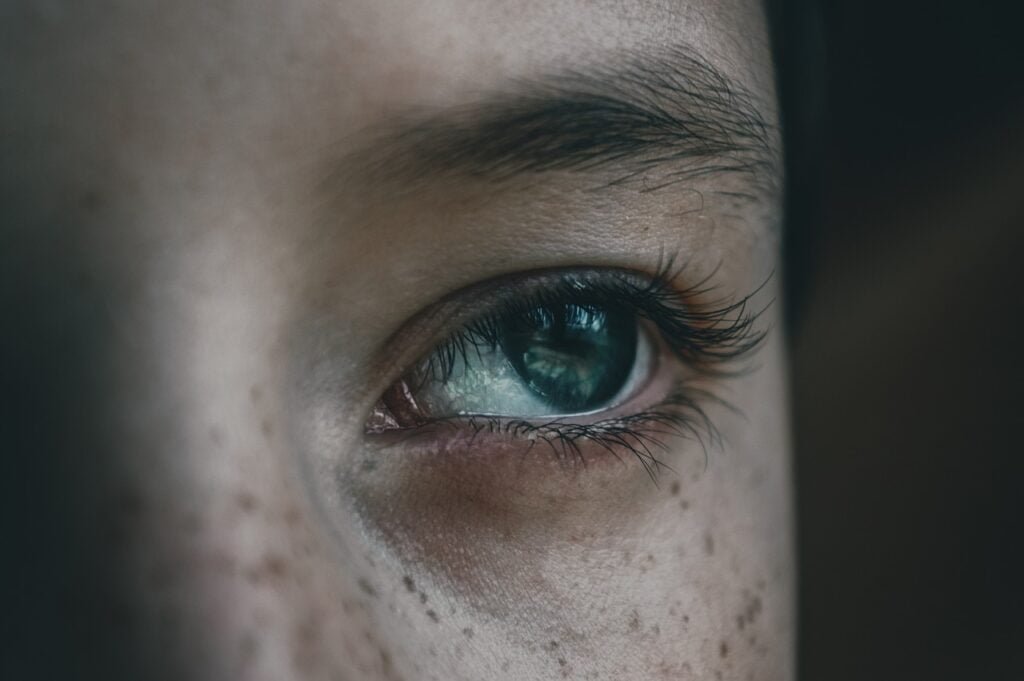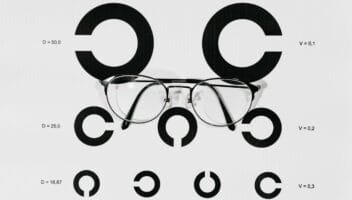Have you ever experienced sudden, strange visual disturbances that seem to come out of nowhere? You might be dealing with ocular migraines.
These unusual events can be alarming if you’re not familiar with them, but understanding ocular migraines is the first step to managing them effectively. In this comprehensive guide, we’ll explore everything you need to know about ocular migraines, from their symptoms and causes to treatment options and prevention strategies.
Ocular migraines, also known as retinal migraines, are a specific type of migraine that primarily affects your vision. Unlike typical migraines that often cause severe headaches, ocular migraines mainly interfere with what you see, causing temporary vision loss or creating bizarre visual effects in one eye.
Whether you’ve experienced ocular migraines yourself or you’re simply curious about this intriguing neurological phenomenon, this blog post will provide you with valuable insights.
So, let’s embark on this journey to unpack the mysteries of ocular migraines. Whether you’re seeking information for yourself, a loved one, or just out of curiosity, you’re in the right place to learn about this fascinating and sometimes perplexing condition.
Let’s dive in and shed some light on the world of ocular migraines.
Table of Contents
What Are Ocular Migraines?

Ocular migraines, also known as retinal migraines, are a unique and often misunderstood type of migraine that primarily affects your vision.
Unlike the more common migraine headaches that many people experience, ocular migraines focus their impact on what you see rather than causing severe pain in your head. This visual disturbance can range from minor annoyances to more significant, albeit temporary, vision loss in one eye.
To truly understand ocular migraines, it’s essential to break down their key characteristics:
Visual Symptoms
The hallmark of ocular migraines is their effect on vision. People experiencing an ocular migraine might see flashing or flickering lights, zigzag lines, shimmering spots, or blind spots in their field of vision. These visual disturbances typically start small and gradually expand over time.
Single Eye Involvement
One of the defining features of a true ocular or retinal migraine is that it affects only one eye. This condition is in contrast to other types of migraines with visual auras, which typically affect both eyes.
Temporary Nature
While the symptoms of an ocular migraine can be alarming, they are usually short-lived. Most episodes last between 5 to 30 minutes, though some can persist for up to an hour.
Lack of Headache
Unlike classic migraines, ocular migraines often occur without the accompanying headache. Some people might experience a mild headache after the visual symptoms subside, but this isn’t always the case.
Frequency
The frequency of ocular migraines can vary greatly from person to person. Some individuals might experience them rarely, perhaps once or twice a year, while others might have them more frequently.
It’s important to note that the term “ocular migraine” is sometimes used interchangeably to describe two distinct conditions, which can lead to confusion:
Retinal Migraine V/s Migraine with Aura
Retinal is what we typically mean when we talk about ocular migraines. These migraines affect only one eye and can cause temporary blindness or visual disturbances in that eye. They’re relatively rare and are considered a true ocular migraine.
Migraine with aura is a more common condition where visual disturbances occur in both eyes, often followed by a headache. While not technically an ocular migraine, many people and even some healthcare providers might use the term “ocular migraine” to describe this condition.
Understanding the difference between these two conditions is crucial for proper diagnosis and treatment. Here’s a more detailed comparison:
Retinal Migraines (True Ocular Migraines)
Affects only one eye
It can cause temporary blindness in the affected eye
Visual symptoms are often described as a small blind spot that enlarges and may be accompanied by flashing lights.
Usually, don’t come with a severe headache, though mild head discomfort may follow.
Are relatively rare
Migraines with Aura
Affect both eyes
Cause visual disturbances but not usually complete blindness
Visual symptoms often include zigzag lines, shimmering spots, or other geometric patterns
Frequently followed by a moderate to severe headache
More common than retinal migraines
It’s worth noting that while ocular migraines are generally harmless and resolve on their own, their symptoms can be similar to those of more serious conditions, such as retinal detachment or transient ischemic attacks (mini-strokes). This similarity underscores the importance of seeking medical attention if you experience visual disturbances, especially if they’re new or different from your usual migraine symptoms.
What Do Ocular Migraines Look Like?

If you’ve never experienced an ocular migraine, it can be challenging to imagine what one looks like. The visual disturbances associated with ocular migraines can be quite varied and often quite dramatic. Let’s dive deeper into the visual phenomena that people with ocular migraines typically report:
Flashing or Flickering Lights: Many people describe seeing sudden bursts of light, similar to camera flashes or strobe lights. These flashes can be white or colored and may appear in different parts of the visual field. Some individuals report that these flashes seem to pulse or throb in rhythm.
Zigzag Lines or Waves: A common visual symptom is the appearance of jagged, zigzag lines. These are often described as looking like fortification patterns or the walls of a medieval castle. The lines may be black and white or brightly colored, and they often shimmer or move across the field of vision.
Blind Spots: Ocular migraines can cause temporary blind spots in your vision. These spots might start small and gradually expand, sometimes to the point where they significantly obstruct vision in the affected eye. Some people describe these blind spots as having blurred or “melted” edges.
Shimmering Spots or Stars: Some individuals report seeing sparkles or stars in their vision, almost like looking at a starry night sky. These spots might twinkle or move around, creating a dazzling but potentially disorienting effect.
Areas of Blank Vision: In some cases, people experience patches of complete vision loss. This isn’t like closing your eyes and seeing blackness; instead, it’s more like parts of the visual field simply disappear or become “blank.”
Kaleidoscope Effect: Some people describe their visual disturbances as resembling a kaleidoscope, with fragmented patterns and colors that shift and change.
Tunnel Vision: In some instances, vision might become constricted, creating a tunnel-like effect where peripheral vision is lost and only central vision remains clear.
Distorted Perception of Size or Shape: Objects might appear larger or smaller than they actually are (a phenomenon known as macropsia or micropsia), or their shapes might seem distorted.
The Progression and Duration of Symptoms
Initial Onset: The visual disturbances typically start small, often near the center of the visual field. Some people describe it as a small dot or blur that they initially might mistake for a smudge on their glasses.
Spread and Expansion: Over several minutes, the visual effects usually spread out or expand. This expansion can be gradual or quite rapid.
Movement: The visual disturbances often appear to move across the field of vision. For example, zigzag lines might seem to march across your sight from one side to the other.
Duration: The length of an ocular migraine episode can vary significantly from person to person and even from one episode to another. While they typically last between 20-30 minutes, some people report episodes as short as a few minutes or as long as an hour.
Resolution: As the episode ends, the visual disturbances generally fade away gradually. Some people report that their vision returns to normal from the edges inward, while others experience a more general fading of the symptoms.
It’s important to note that these visual symptoms occur in only one eye during a true ocular (retinal) migraine. However, it can sometimes be difficult to tell which eye is affected unless you cover one eye at a time. In contrast, visual auras associated with classic migraines typically affect both eyes.
Who Gets Ocular Migraines?

Ocular migraines can affect anyone, regardless of age, gender, or background. However, certain groups of people are more likely to experience these visual disturbances. Understanding who is at higher risk can help with early recognition and management of the condition. Let’s delve deeper into the demographics and risk factors associated with ocular migraines:
Gender Differences
Women are significantly more likely to experience ocular migraines than men. This gender disparity is similar to what we see with other types of migraines. The exact reasons for this are not fully understood, but hormonal factors are thought to play a crucial role. Fluctuations in estrogen levels, particularly during menstruation, pregnancy, and menopause, can trigger migraines in many women. Some women report experiencing ocular migraines for the first time during pregnancy or when starting hormonal contraceptives.
Age Factor
While ocular migraines can occur at any age, they are more commonly reported in people under 40 years old. The onset often occurs in the late teens or early twenties, with many people experiencing their first ocular migraine during this time. However, it’s important to note that older adults can also develop ocular migraines, even if they’ve never had them before. The frequency of ocular migraines tends to decrease with age for many individuals.
Family History
There appears to be a strong genetic component to ocular migraines. People with a family history of migraines or ocular migraines are more likely to experience them themselves. If you have a parent or sibling who suffers from these conditions, your risk is higher. This familial link suggests that there may be genetic factors that predispose certain individuals to ocular migraines. However, the specific genes involved are still being researched.
Migraine History
Individuals who experience regular migraines, especially migraines with aura, are more likely also to have ocular migraines. In fact, many people who have ocular migraines also suffer from other types of migraines. The connection between these conditions suggests shared underlying mechanisms, although ocular migraines are considered a distinct subtype.
What Causes Ocular Migraines?
The exact cause of ocular migraines remains a subject of ongoing research and debate in the medical community.
The underlying mechanisms of ocular migraines are not fully understood. Still, they are believed to be related to changes in blood flow to the retina or parts of the brain responsible for vision processing. Some researchers theorize that these changes might be triggered by the same factors that cause other types of migraines, such as stress, certain foods, hormonal changes, or environmental factors.
While scientists haven’t pinpointed a single, definitive cause, they have developed several theories and identified potential triggers. Let’s delve deeper into what we currently understand about the causes of ocular migraines:
Vascular Theory
One of the leading theories suggests that ocular migraines are caused by changes in blood flow to the eye or specific areas of the brain responsible for vision processing. This theory proposes that blood vessels in these areas may suddenly narrow (vasoconstriction) and then widen (vasodilation), disrupting normal blood flow. This disruption could potentially lead to the visual disturbances characteristic of ocular migraines.
Cortical Spreading Depression
Some researchers believe that ocular migraines may be related to a phenomenon called cortical spreading depression (CSD). CSD is a wave of electrical activity that spreads across the surface of the brain, temporarily altering neural function. This electrical disturbance could potentially affect the visual cortex, leading to the visual symptoms experienced during an ocular migraine.
Neurotransmitter Imbalances
Another theory focuses on the role of neurotransmitters, particularly serotonin. Fluctuations in serotonin levels have been associated with various types of migraines, and these changes could also trigger ocular migraines.
Genetic Factors
The tendency to experience ocular migraines often runs in families, suggesting a genetic component. Researchers are working to identify specific genes that might increase susceptibility to these and other types of migraines.
Triggers

While these underlying mechanisms may create a predisposition to ocular migraines, various external factors can trigger individual episodes. These triggers can vary significantly from person to person, but some common ones include:
Stress: High levels of stress or anxiety can trigger ocular migraines in many people. This relation could be due to the physiological changes that occur in the body during periods of stress, including changes in blood flow and hormone levels.
Dietary Factors: Certain foods and drinks have been associated with migraine triggers. These include aged cheeses, which contain tyramine; caffeine (both excessive consumption and caffeine withdrawal); chocolate; alcoholic beverages, especially red wine; artificial sweeteners; monosodium glutamate (MSG); and nitrates and nitrites, found in processed meats.
Sensory Stimuli: For some people, certain sensory inputs can trigger ocular migraines. These include bright or flickering lights, loud noises, and strong odors.
Environmental Factors: Changes in weather or barometric pressure, high altitude, and strong winds can all potentially trigger ocular migraines in susceptible individuals.
Hormonal Changes: This is particularly relevant for women. Fluctuations in estrogen levels, such as those that occur during menstruation, pregnancy, or menopause, can trigger migraines in some women. Some women report experiencing ocular migraines for the first time during pregnancy or when starting hormonal contraceptives.
Sleep Disturbances: Both lack of sleep and oversleeping can potentially trigger ocular migraines in some individuals.
Physical Factors: Intense physical exertion, sexual activity, and changes in posture or head position can all potentially trigger ocular migraines.
- Dehydration and Hunger: Skipping meals or not drinking enough water can lead to ocular migraines in some people.
- Medications: Certain medications, even the ones used to treat other types of migraines, can potentially trigger ocular migraines in some individuals.
- Eye Strain: Prolonged periods of intense focus, particularly on digital screens, can lead to eye strain, which may trigger ocular migraines in susceptible individuals.
Are Ocular Migraines Dangerous?
For most people, ocular migraines are annoying but not dangerous. They usually go away on their own and don’t cause any lasting damage to your eyes or vision.
However, it’s important to know that the symptoms of an ocular migraine can be similar to those of more serious conditions, like a detached retina or a stroke. If you’re experiencing visual disturbances for the first time, or if your symptoms are different from your usual ocular migraines, it’s a good idea to see a doctor to rule out other problems.
In rare cases, people who have ocular migraines might be at a slightly higher risk for certain eye problems or stroke. But for most folks, they’re just a temporary inconvenience.
How Are Ocular Migraines Diagnosed?
If you think you might be having ocular migraines, the first step is to see a doctor. They’ll probably ask you a bunch of questions about your symptoms, like:
What do you see during an episode?
How long do the visual symptoms last?
Do you get a headache afterward?
How often do these episodes happen?
Do you have any other health conditions?
Your doctor might also do some tests to rule out other possible causes of your symptoms. These could include:
An eye exam to check the health of your eyes
Imaging tests like MRI or CT scans to look at your brain
Blood tests to check for other health issues
There’s no specific test for ocular migraines, so the diagnosis is usually based on your symptoms and ruling out other conditions.
How to Treat Ocular Migraines

The good news is that ocular migraines usually don’t need any special treatment. They tend to go away on their own within an hour or so. However, there are some things you can do to help manage them:
1. Rest and relax: When you feel an ocular migraine coming on, try to find a quiet, dark place to rest until it passes.
2. Close your eyes: This can help reduce visual disturbances and make you more comfortable.
3. Take pain relievers: If you get a headache after the visual symptoms, over-the-counter pain medications like ibuprofen or acetaminophen might help.
4. Stay safe: If you’re driving or doing something that requires good vision when an ocular migraine hits, stop what you’re doing and wait for it to pass.
For people who get ocular migraines often or find them really disruptive, doctors might prescribe medications to help prevent them. These could include:
Blood pressure medications
Antidepressants
Remember, always talk to your doctor before starting any new medications, even over-the-counter ones.
Can You Prevent Ocular Migraines?
While you can’t always prevent ocular migraines, there are some things you can do to reduce how often they happen:
1. Identify and avoid triggers: Keep a diary of when you get ocular migraines and what you were doing or eating beforehand. Knowing your migraine triggers can help you spot patterns and avoid things that might be triggering them.
2. Manage stress: Since stress is a common trigger, finding ways to relax and de-stress might help. Try things like deep breathing, meditation, or yoga.
3. Get enough sleep: Aim for 7-9 hours of sleep each night.
4. Eat regularly: Don’t skip meals, as low blood sugar can trigger migraines in some people.
5. Stay hydrated: Drink plenty of water throughout the day.
6. Exercise regularly: Physical activity can help reduce stress and improve overall health, which might help prevent migraines.
7. Limit screen time: Too much time staring at screens can strain your eyes and potentially trigger migraines.
Living with Ocular Migraines
If you get ocular migraines, it’s important to learn how to manage them in your daily life. Here are some tips:
1. Be prepared: If you know you’re prone to ocular migraines, always have a plan for what to do if one strikes when you’re out and about.
2. Inform others: Let your family, friends, and coworkers know about your condition so they can help if needed.
3. Take breaks: If you spend a lot of time looking at screens, take regular breaks to rest your eyes.
4. Wear sunglasses: Bright light can trigger migraines in some people, so protect your eyes when you’re outside.
5. Stay positive: Remember that ocular migraines, while annoying, are usually harmless and temporary.
When to See a Doctor
While ocular migraines are usually not serious, there are times when you should definitely see a doctor:
If you’re experiencing visual disturbances for the first time
If your symptoms are different from your usual ocular migraines
If your ocular migraines become more frequent or severe
If you have other symptoms along with the visual disturbances like weakness, numbness, or trouble speaking
If your vision doesn’t return to normal after an hour
Remember, it’s always better to be safe than sorry when it comes to your health, especially your vision.
Wrapping Up
Ocular migraines can be a weird and sometimes scary experience, but for most people, they’re nothing to worry about. They usually pass quickly and don’t cause any lasting damage. However, because they can sometimes be confused with more serious conditions, it’s always a good idea to get checked out by a doctor if you’re experiencing these symptoms for the first time.
Remember, everyone’s experience with ocular migraines is different. What triggers them, how often they happen, and how they feel can vary from person to person. By learning about your patterns and working with your doctor, you can find the best ways to manage your ocular migraines and minimize their impact on your life.
Your eyes are precious, so take care of them, listen to your body, and don’t hesitate to seek medical advice if something doesn’t feel right. Here’s to clear vision and migraine-free days ahead!




